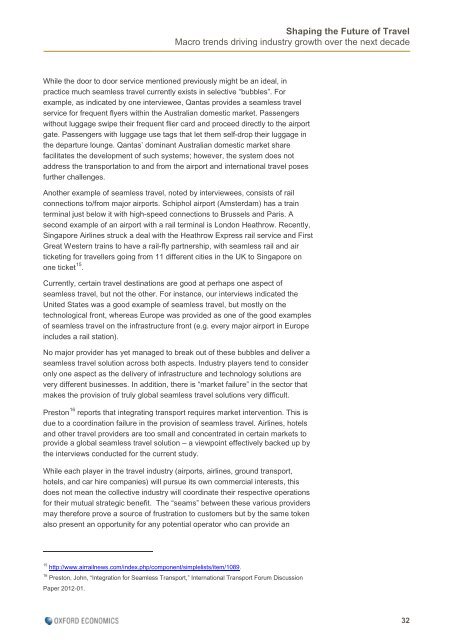Amadeus-Shaping-the-Future-of-Travel-MacroTrends-Report
Amadeus-Shaping-the-Future-of-Travel-MacroTrends-Report
Amadeus-Shaping-the-Future-of-Travel-MacroTrends-Report
You also want an ePaper? Increase the reach of your titles
YUMPU automatically turns print PDFs into web optimized ePapers that Google loves.
<strong>Shaping</strong> <strong>the</strong> <strong>Future</strong> <strong>of</strong> <strong>Travel</strong><br />
Macro trends driving industry growth over <strong>the</strong> next decade<br />
While <strong>the</strong> door to door service mentioned previously might be an ideal, in<br />
practice much seamless travel currently exists in selective “bubbles”. For<br />
example, as indicated by one interviewee, Qantas provides a seamless travel<br />
service for frequent flyers within <strong>the</strong> Australian domestic market. Passengers<br />
without luggage swipe <strong>the</strong>ir frequent flier card and proceed directly to <strong>the</strong> airport<br />
gate. Passengers with luggage use tags that let <strong>the</strong>m self-drop <strong>the</strong>ir luggage in<br />
<strong>the</strong> departure lounge. Qantas’ dominant Australian domestic market share<br />
facilitates <strong>the</strong> development <strong>of</strong> such systems; however, <strong>the</strong> system does not<br />
address <strong>the</strong> transportation to and from <strong>the</strong> airport and international travel poses<br />
fur<strong>the</strong>r challenges.<br />
Ano<strong>the</strong>r example <strong>of</strong> seamless travel, noted by interviewees, consists <strong>of</strong> rail<br />
connections to/from major airports. Schiphol airport (Amsterdam) has a train<br />
terminal just below it with high-speed connections to Brussels and Paris. A<br />
second example <strong>of</strong> an airport with a rail terminal is London Heathrow. Recently,<br />
Singapore Airlines struck a deal with <strong>the</strong> Heathrow Express rail service and First<br />
Great Western trains to have a rail-fly partnership, with seamless rail and air<br />
ticketing for travellers going from 11 different cities in <strong>the</strong> UK to Singapore on<br />
one ticket 15 .<br />
Currently, certain travel destinations are good at perhaps one aspect <strong>of</strong><br />
seamless travel, but not <strong>the</strong> o<strong>the</strong>r. For instance, our interviews indicated <strong>the</strong><br />
United States was a good example <strong>of</strong> seamless travel, but mostly on <strong>the</strong><br />
technological front, whereas Europe was provided as one <strong>of</strong> <strong>the</strong> good examples<br />
<strong>of</strong> seamless travel on <strong>the</strong> infrastructure front (e.g. every major airport in Europe<br />
includes a rail station).<br />
No major provider has yet managed to break out <strong>of</strong> <strong>the</strong>se bubbles and deliver a<br />
seamless travel solution across both aspects. Industry players tend to consider<br />
only one aspect as <strong>the</strong> delivery <strong>of</strong> infrastructure and technology solutions are<br />
very different businesses. In addition, <strong>the</strong>re is “market failure” in <strong>the</strong> sector that<br />
makes <strong>the</strong> provision <strong>of</strong> truly global seamless travel solutions very difficult.<br />
Preston 16 reports that integrating transport requires market intervention. This is<br />
due to a coordination failure in <strong>the</strong> provision <strong>of</strong> seamless travel. Airlines, hotels<br />
and o<strong>the</strong>r travel providers are too small and concentrated in certain markets to<br />
provide a global seamless travel solution – a viewpoint effectively backed up by<br />
<strong>the</strong> interviews conducted for <strong>the</strong> current study.<br />
While each player in <strong>the</strong> travel industry (airports, airlines, ground transport,<br />
hotels, and car hire companies) will pursue its own commercial interests, this<br />
does not mean <strong>the</strong> collective industry will coordinate <strong>the</strong>ir respective operations<br />
for <strong>the</strong>ir mutual strategic benefit. The “seams” between <strong>the</strong>se various providers<br />
may <strong>the</strong>refore prove a source <strong>of</strong> frustration to customers but by <strong>the</strong> same token<br />
also present an opportunity for any potential operator who can provide an<br />
15 http://www.airrailnews.com/index.php/component/simplelists/item/1089.<br />
16 Preston, John, “Integration for Seamless Transport,” International Transport Forum Discussion<br />
Paper 2012-01.<br />
32


